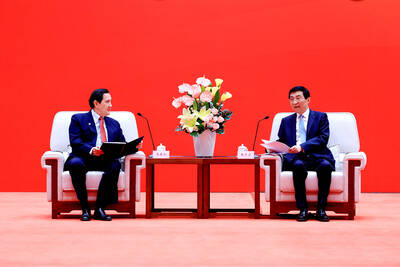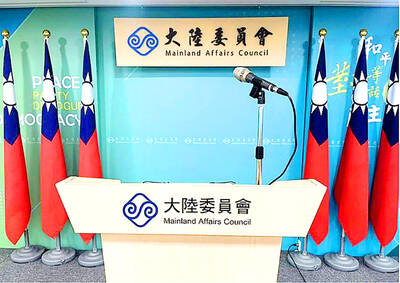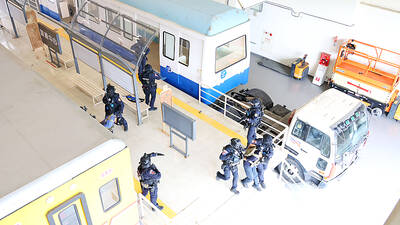Employees at the world’s biggest Apple Inc iPhone factory were beaten and detained in protests over contract disputes amid COVID-19 pandemic restrictions, videos on social media showed yesterday.
Videos that said they were filmed at the factory in Zhengzhou showed thousands of people facing rows of police in white protective suits with plastic riot shields.
Police kicked and hit a protester with clubs after he grabbed a metal pole that had been used to strike him.

Photo: AFP
Other videos showed protesters spraying fire extinguishers toward police.
A protest began on Tuesday over complaints that Foxconn Technology Group (富士康科技集團), known as Hon Hai Precision Industry Co (鴻海精密) in Taiwan, changed conditions for new workers who were attracted by offers of higher pay, said Li Sanshan, an employee.
Li said that he quit a catering job in response to advertising that promised 25,000 yuan (US$3,500) for two months of work.
Li, 28, said that workers were angry after being told they had to work two additional months at lower pay to receive the 25,000 yuan.
“Foxconn released very tempting recruiting offers and workers from all parts of the country came only to find they were being made fools of,” Li said.
The protest lasted through yesterday morning as thousands of workers gathered outside dormitories and confronted factory security workers, he said.
Foxconn yesterday confirmed overnight “violence” at its iPhone factory in Zhengzhou and vowed to “avoid similar incidents.”
The company said that workers had complained about pay and conditions at the plant, but it denied that it had housed new recruits with staff who had tested positive for COVID-19, it said in a statement.
“Regarding any violence, the company will continue to communicate with employees and the government to prevent similar incidents from happening again,” the statement said.
Foxconn said earlier that the Zhengzhou factory uses “closed-loop management,” which means employees live at their workplace with no outside contact.
A man who identified himself as the Chinese Communist Party secretary in charge of community services was shown in a video posted on the Sina Weibo social media platform urging protesters to withdraw.
He assured them that their demands would be met.
Protests have flared as the number and severity of COVID-19 outbreaks have risen across China, including in Beijing, while images of maskless crowds at the FIFA World Cup in Qatar have sparked anger, with people questioning the Chinese government’s “zero COVID-19” approach.
“Some people are watching World Cup matches in person with no masks, some have been locked at home for a month, locked on campus for two months without even being able to step out the door,” a Guangdong resident wrote online yesterday.
“Who has stolen my life? I won’t say,” they wrote.
Another user from Shaanxi Province said they were “disappointed” in their country.
“The World Cup has allowed most Chinese people to see the real situation abroad, and worry about the economy of the motherland and their own youth,” the second user wrote.
An open letter questioning China’s COVID-19 policies and asking if China was “on the same planet” as Qatar spread on the WeChat messaging app on Tuesday before censors removed it from the platform.

CHIP WAR: The new restrictions are expected to cut off China’s access to Taiwan’s technologies, materials and equipment essential to building AI semiconductors Taiwan has blacklisted Huawei Technologies Co (華為) and Semiconductor Manufacturing International Corp (SMIC, 中芯), dealing another major blow to the two companies spearheading China’s efforts to develop cutting-edge artificial intelligence (AI) chip technologies. The Ministry of Economic Affairs’ International Trade Administration has included Huawei, SMIC and several of their subsidiaries in an update of its so-called strategic high-tech commodities entity list, the latest version on its Web site showed on Saturday. It did not publicly announce the change. Other entities on the list include organizations such as the Taliban and al-Qaeda, as well as companies in China, Iran and elsewhere. Local companies need

CRITICISM: It is generally accepted that the Straits Forum is a CCP ‘united front’ platform, and anyone attending should maintain Taiwan’s dignity, the council said The Mainland Affairs Council (MAC) yesterday said it deeply regrets that former president Ma Ying-jeou (馬英九) echoed the Chinese Communist Party’s (CCP) “one China” principle and “united front” tactics by telling the Straits Forum that Taiwanese yearn for both sides of the Taiwan Strait to move toward “peace” and “integration.” The 17th annual Straits Forum yesterday opened in Xiamen, China, and while the Chinese Nationalist Party’s (KMT) local government heads were absent for the first time in 17 years, Ma attended the forum as “former KMT chairperson” and met with Chinese People’s Political Consultative Conference Chairman Wang Huning (王滬寧). Wang

CROSS-STRAIT: The MAC said it barred the Chinese officials from attending an event, because they failed to provide guarantees that Taiwan would be treated with respect The Mainland Affairs Council (MAC) on Friday night defended its decision to bar Chinese officials and tourism representatives from attending a tourism event in Taipei next month, citing the unsafe conditions for Taiwanese in China. The Taipei International Summer Travel Expo, organized by the Taiwan Tourism Exchange Association, is to run from July 18 to 21. China’s Taiwan Affairs Office spokeswoman Zhu Fenglian (朱鳳蓮) on Friday said that representatives from China’s travel industry were excluded from the expo. The Democratic Progressive Party government is obstructing cross-strait tourism exchange in a vain attempt to ignore the mainstream support for peaceful development

ELITE UNIT: President William Lai yesterday praised the National Police Agency’s Special Operations Group after watching it go through assault training and hostage rescue drills The US Navy regularly conducts global war games to develop deterrence strategies against a potential Chinese invasion of Taiwan, aimed at making the nation “a very difficult target to take,” US Acting Chief of Naval Operations James Kilby said on Wednesday. Testifying before the US House of Representatives Armed Services Committee, Kilby said the navy has studied the issue extensively, including routine simulations at the Naval War College. The navy is focused on five key areas: long-range strike capabilities; countering China’s command, control, communications, computers, cyber, intelligence, surveillance, reconnaissance and targeting; terminal ship defense; contested logistics; and nontraditional maritime denial tactics, Kilby